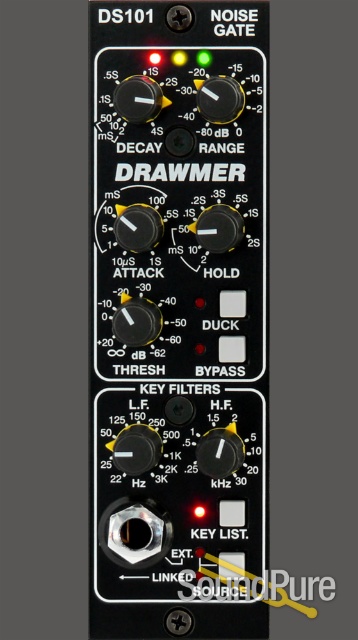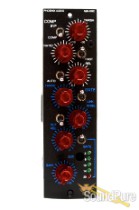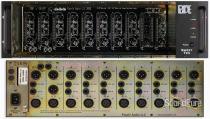-
Call Us Toll Free888-528-9703
-
Local/International (+1)919-682-5552
- Call Us! Toll Free! 888-528-9703
- Local / International (+1) 919-682-5552

Drawmer DS101 - Noise Gate for the 500 Series From Drawmer
This fully featured 500 series noise gate will save the day on your next gig.
$515.00
No Sales Tax in 45 States.
Learn More.
Retail: $569.00
"Experience the Difference"
Our Free 3-Year Warranty!
In addition to the standard included manufacturer warranty, virtually all new products carry our exclusive, industry-leading, absolutely free, Sound Pure 3-Year Warranty, which includes PARTS & LABOR. This high-value perk is our way of providing the ultimate in added value to enhance the unique personal touch our small, dedicated team contributes to each purchase.
Learn more »
This Product Ships Free!
Products ship from our well-located, climate- and humidity-controlled warehouse absolutely free (inside the continental USA). Low-cost international shipping options exist for most products.
Contact us for details »
Contact us for up-to-date delivery estimate.
 Payments as low as $45/mo.
Payments as low as $45/mo.
0% interest financing available. See all options.
Manufacturer's Description from Drawmer
The Industry-Standard High-End Noise-Gate comes to the 500 Series!
The DS101 is the first noise gate designed specifically for the 500 Series rack system and takes its place alongside the Drawmer family of industry standard Noise Gates, such as the DS201, DS501 and DS404. Anyone familiar with those units will immediately be at home with the DS101.
Based on a single-channel of the DS201 the DS101 is a sophisticated noise gate incorporating a number of features pioneered by Drawmer, which are invaluable to the sound engineer, such as variable high and lowpass filters for “frequency conscious gating.”
Other features include comprehensive envelope control, attack, hold, decay, and range, plus a whole host of other features, all adding up to one amazing processor.
When placed side by side in a 500 series rack two or more gates can be linked using the new infra red triggering mechanism employed on the DS101. This means that any number of gates can be linked with each having their own envelope shaping whilst the trigger pulse passes through unchanged, this opens up a whole world of “envelope follower” effects limited only by your imagination.
Features:
-
Fully featured noise gate based on the industry standard DS201.
- Takes up a single 500 series slot.
- Proprietary Hysteris or “trigger stabilization” to prevent “chatter” around the threshold.
- Fully variable high pass and low pass filters for “frequency conscious” gating.
- Comprehensive envelope control, attack, hold, decay, and range.
- External triggering via key input or the new IR trigger pulse from another DS101.
- “Key Listen” facility.
- Extremely fast attack time, to preserve the natural attack of the sound.
- Linkable - up to ten units in one rack space - with individual envelope shaping.
- Drawmer “traffic lighting” metering.
- Can be used for “Gating” or “Ducking”.
- Low noise design.
Setting up noise gates can be tedious and unrewarding. For example, when attempting to separate a signal from unwanted noise or crosstalk that is relatively high in level, spurious triggering of the gate by unwanted components within the sound can be a serious problem. This can often be experienced in the studio when recording a drum kit. If a gate is used to clean up the snare drum sound it is quite likely that the nearby hi-hats will spill into the snare drum microphone and cause the gate to open. Increasing the threshold level may cure this problem, but then there is a very real danger that any quieter snare drum beats may not cause the gate to open at all and the performance can easily be ruined.
The DRAWMER solution to this problem is the inclusion of two variable filters, one high-pass and one low-pass, which act upon the side-chain keying circuitry. By setting the output switch to key listen the user can hear the action of the filters and adjust them to reject high frequency spillage from the hi-hats. This now enables the gate to only open on the lower frequencies present in the snare drum.
The very fast attack of the DS101 means that it can open in a matter of micro seconds, thus preserving the natural attack of whatever sound is being gated and the comprehensive envelope controls mean that the gain can be changed at whatever rate best suits the material being processed. With vocals for example, a fairly fast attack is needed so as not to clip the leading consonants but a slower release time will prevent the end of words being clipped off and will also fade out any noise gradually rather than cutting it off abruptly. This latter point is very important as the human ear is far more sensitive to rapidly changing noise levels than to a constant low level noise.
Another important role played by the gate is in the reshaping of existing sounds. An example of this might involve a simple sampling delay line used to store a sound to be re-triggered later and added to a mix. A gate can be used to impart a slower attack or faster decay to the sound and careful setting of the decay envelope can effectively hide any noise present at the end of the sample. When using a sampler or drum machine the gate can be considered a triggered envelope shaper, and the wide range allowed by the envelope controls make the DS101 ideal for this application.
The unit can be switched to accept a key input, which allows the gate to be triggered externally. An example of this would be to use a snare drum signal to open the gate on a separate ambient microphone to create a natural alternative to gated reverb.
With a rack full of DS101's each can be individually switched from Gating to Ducking for 'voice over' applications or the removal of 'clicks' and 'pops'.

About Manufacturer
The Beginning: The name Drawmer is synonymous with professional signal processing in recording studio, broadcast and live sound reinforcement environments. The company which is based in Yorkshire, England was founded by Ivor Drawmer whose passion was designing audio circuits. "The whole thing started in 1981," explains Drawmer. "I had been playing keyboards with bands in Yorkshire, but that wasn't going so well and also I wasn't getting any younger. With the encouragement of friends I built a small batch of stereo delay lines, which I called the Multitracker, and that was the start of Drawmer." The DS201 Gate: In 1982 Drawmer revolutionised gating by introducing the DS201 Dual Noise Gate, the world's first 'frequency conscious' noise gate. "It came about from working with a producer called Phil Chapman, who wanted me to build him a gate. Without doing any research I built this thing that switched on, held for a certain amount of time and then just switched off. In practice of course it was no good at all, so I then spent some time going around studios looking at how gates were being used. What really surprised me was how long engineers spent fiddling with gates trying to get them optimally set up and I realised very quickly that a better design was needed." The DS201's unique High-Pass and Low-Pass key filters, comprehensive envelope control and ultra-fast attack time has since made it the 'industry standard' gate throughout the world. The 201 transformed the gate from what had previously been a simple "on/off" device to a powerful creative tool playing a significant role in modern music production. "It was the kind of unit that people discovered uses for and it immediately enabled engineers to do the things they'd always dreamed of with minimum fuss," says Drawmer. Very little has changed to the design of the DS201over the years, and Ivor Drawmer claims it sells as well now as it did back in the early 1980s. "It's astounding where they all go, but to date we've sold tens of thousands of units," he says. The 1960 Mic-Pre/Tube Compressor: In 1984 Drawmer released the original 1960 Mic Pre-Amp/Vacuum Tube Compressor which combined two high performance mic pre-amps, two 'soft knee' tube compressors and an instrument pre-amp with EQ. The 1960 was the first self contained 'front end', and for many recordists who required only one or two microphone input channels it replaced the mixing console, assuring the user of a high quality signal path with a 'distinctive' sound. The concept of the 1960 was to combine the 'warmth and character' of eight active tube stages with the low noise and reliability of solid state electronics. The 1960 has been adopted by producers and musicians around the world and acclaimed as the ultimate direct interface between the sound source and the recording medium. Although the basic design and features of the 1960 remain the same to this day, periodic upgrades have been performed, the latest being the addition of high-pass filters and overload LEDs to the mic pre-amp. As the retro movement has escalated, Drawmer says there has been a dramatic surge in 1960 sales which now puts the unit on a par with the gates. Programme Adaptive: During 1989 Drawmer developed a new proprietary gating circuitry which it entitled 'programme adaptive'. This intelligent auto-circuitry was capable of analysing the dynamic content of the incoming signal and constantly optimising the 'attack', 'hold', 'ratio' and 'release' parameters thereby creating a much smoother gating action than previously available. The first products to incorporate Drawmer's 'programme adaptive' circuitry were the DL241 Auto Compressor released in 1990 and the DS404 Quad Noise Gate released in 1991. Also developed in 1989 was a new limiter circuitry which performed 'Zero Overshoot', 'Zero Response Time' transparent limiting. This was also included in the DL241 Auto Compressor and later the DL441 Quad Auto Compressor Limiter. In 1992 Drawmer took the innovative step of incorporating their newly developed 'Dynamics Spectral Enhancement' circuitry into a high quality compressor/limiter which enabled the user to dynamically boost any high frequency energy lost during the full band compression process. The resulting product, the DL251 Spectral Compressor was enthusiastically received by the mastering, broadcast and studio industries. The 1961 Tube Equaliser: With the new series of compressors becoming established amongst professional users Drawmer decided to expand its range of tube products and in 1994 released the 1961 Vacuum Tube Equaliser. An interesting 1961 design feature was the inclusion of a variable input level control on each of the two channels. This design approach allows the user to control the amount of 'warmth' by deciding how hard to drive the tubes giving a sound as 'clean' as the best discrete solid state designs or as 'hot' as the 'hottest' vintage tube models. The 1962 Digital Vacuum Tube Pre-Amp: The 1962 Digital Vacuum Tube Pre-Amp is a hybrid combining solid state, valve and digital technology. It comprises a high performance stereo analog pre-amp with 3-band EQ, low and high pass filters, low and high frequency dynamic enhancement, limiting and variable tube drive which feeds directly to 24-bit A/D converters. As well as analog outputs the 1962 is equipped with AES/EBU, SP-DIF and Tascam's TDIF or Alesis ADAT digital interfaces. "The concept is to offer very high quality analog with optional processing and tube warmth before converting to digital via the high resolution converters," explains Ivor Drawmer. The MX Series: In contrast to the 'high end' 1962, the MX30 Gated/Comp/Limiter and MX40 Punch Gate are low cost entry level dynamics processors bringing Drawmer's professional processing into a wider M.I. market place. The MX range has recently been expanded with the MX50 Dual De-Esser and MX60 Front End One. Digital Masterflow and Future Developments: Digital technology features strongly in Drawmer's future products, and the new Masterflow range of processing units translate some of Drawmer's existing designs into the digital domain. The company has also joined the growing list of manufacturers working on a series of TDM software modules for Digidesign's Pro Tools System and has recently developed a plug-in for the Mackie D8B Digital Console. Ivor Drawmer now works in conjunction with a team of highly qualified technicians with both analog and digital skills. Their design brief is to continue to create innovative and unique products based on feedback from the Sales and Marketing department and the Drawmer International Distributor network.
Specifications
General
| Compatibility |
API 500 Series Rack Frame
|
Inputs/Outputs
| Audio I/O |
1x 1/4" TS Line Input (External Key)
|
Power
| Power Source |
Proprietary Interface (Built-In)
|
Physical
| Mounting |
Front: 2x Standard Rackmount Screw
|
| Color |
Black
|
| Material of Construction |
Metal
|













